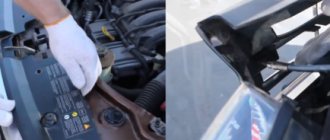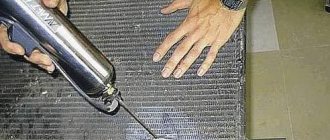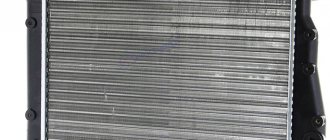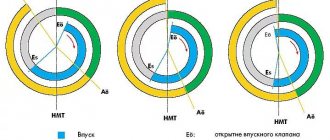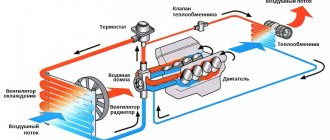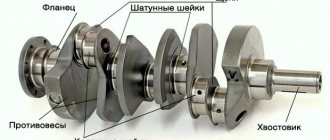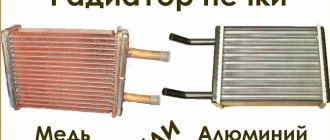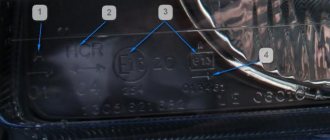Every second motorist knows that the most popular and useful car option is the installation of a special durable mesh on the front bumper, which performs the function of protection. The main task of this part is to protect the radiator structure made of copper or aluminum, since it is quite fragile. Small and large stones can get into it, breaking through the decorative grille.
But is the installation of such a part mandatory? Now we will try to figure this out together.
What is a radiator protection mesh?
A radiator in a car is necessary to cool the engine during operation. For its proper operation, you need to monitor the condition of the radiator “honeycombs” and also regularly change the antifreeze. The radiator “honeycombs” can be damaged by various debris flying off the roadway. For drivers who are afraid of such troubles, a protective mesh for the radiator is offered as an additional option.
The radiator protection mesh can be installed in the car bumper or radiator grille.
note
Some drivers install two nets, but we highly recommend not doing this.
A few myths about installing a protective grille
In the circles of inexperienced motorists, there are several opinions regarding the fact that radiator cells contribute to engine overheating and do not provide any benefit. Beginners argue that if the mesh is too thin, it will:
- will quickly become clogged with debris and completely clog the radiator;
- will contribute to engine overheating in traffic jams;
- will not be blown with air, which will lead to poor heat dissipation.
All these statements are just myths, since aluminum or copper is usually used to make the radiator. It is able to dissipate heat well even without blowing due to its ribbed design, so even the thinnest part will pass incoming air.
In any case, installing a protective element on your vehicle is a personal matter for each car enthusiast. But experienced drivers recommend not to neglect the installation of radiator protection in order to protect their car.
What are the differences between radiator protection nets?
As we noted above, the mesh can be installed directly in the radiator grille or in the car bumper. Depending on the car model and the design of its front end, it makes sense to choose one or the other option for installing the mesh.
The meshes also differ in the material from which they are made. Most often it is aluminum or metal.
Another significant difference is the cell size. The smaller it is, the smaller elements from the road surface can potentially get into the radiator.
What are they and what are they made from?
Today, there are two types of grating mesh. They can be:
- Factory - purchased at car dealerships for specific car models;
- Homemade - made by car owners.
As a rule, production uses a metal mesh (but with different cell sizes) or durable plastic, which is almost indestructible when exposed to low temperatures. According to the fastening method, they can also be divided into two categories:
- Rigid fastening to the decorative part of the car. Ties or bolts can be used;
- Removable for easy removal for cleaning.
Note! Experienced car enthusiasts recommend “rigid mounting” to eliminate rattling. They won't fall off, they won't rub anything, sitting rigidly.
It would be rational to make such improvements when frequently traveling between cities along highways, especially in the summer. The whole point is that modern cars have large radiators (they can go very down) and double grilles should perform a protective function. It is attached between the headlights, and the second one is built into the bottom of the bumper by many manufacturers. But why sometimes bars don’t help at all?
The answer is simple: modern grilles increasingly serve a decorative function; they are made up of large cells, into which not only flies can get, but also stones accidentally thrown out from under the tires of a car driving in front of your car. These factors can damage the surface of the radiator. It’s not so easy to break through it, but it’s quite possible to get clogged with insects and dust. The decision to attach a protective grille is a smart move. Unnecessary charms will settle on it, and you can get rid of them at a car wash.
Advantages of a mesh for radiator protection
The main advantage of the mesh is that it protects the radiator from stones and other elements from the road surface getting into it.
Experts recommend installing a radiator protection mesh for drivers who often have to drive in fast traffic. For example, drivers who regularly drive along country roads. It is not recommended for other drivers to install a net.
note
Almost no car model offers a radiator protection mesh, even as an additional option that can be purchased when purchasing a car.
Stones from under the wheels
Stones that fly from under the wheels pass through the standard grille and pierce the soft honeycomb of the cooling radiator. They break through and crumple. Also, the intercooler may be damaged. Among used cars, many have a broken radiator. They don’t even change it, but use “cold welding”, which leads to leaks or steaming. But all this will lead to more serious problems with the engine.
As a rule, the radiator of cars with powerful engines and automatic transmissions is punctured. They have many radiators, and air is very valuable, especially when driving frequently at more than 3,000 engine speeds. In this case, everything that may not allow air to pass through is eliminated, so there is no protection from flying stones.
Disadvantages of mesh for radiator protection
It may seem that a radiator protective mesh is a necessary item for every car. But this is not true at all. Many automakers strongly do not recommend installing such a net on a car, even to the extent of voiding the car owner’s warranty if this rule is violated.
This is due to the fact that installing such a mesh may prevent the radiator from receiving enough air for normal operation. As a result, this can lead to engine overheating and all the ensuing consequences.
note
This problem is especially real if the mesh is used for a long time without replacement. Small cells become clogged with stones, dry leaves and other debris, causing air to stop flowing through them normally.
In addition to this factor, there are several other disadvantages of such a grid:
- In a collision with, for example, a pedestrian, the front part of the car may not behave as the automaker intended (not crumpling enough, thereby not softening the impact);
- Aesthetic. Not everyone likes the appearance of such a mesh, which often does not fit into the design of the car;
- Reduced aerodynamics. Even if only slightly, a mesh with small cells worsens the aerodynamic characteristics of the car.
Whether or not to install a mesh to protect the radiator is the choice of every car owner. As we noted above, in urban environments this does not make much sense.
( 15 votes, average: 4.80 out of 5)
How to clean the car interior from cat or dog hair
Installing a radio in a car: instructions
Related Posts
Free from insects and stones
There are two types of protection: from insects and dirt, as well as from stones. For the first purpose, a mesh with small sections is suitable. It can even be soft and attached to the back of the standard radiator grille. You can buy it for one or another model already assembled or make it yourself from construction polyethylene mesh. Such devices will not hurt when traveling during the poplar fluff season or in the fall, when dry yellow leaves rise from the roads and fly into the air intakes. They will also be useful in regions where, in the fall, hordes of moths, bugs and midges are born, specially flying into the headlights at night. In one trip, they crust over not only the radiator, but also the headlights and windshield.
But protection from stones requires a much more careful approach. A frame with a metal mesh or lattice must be installed by qualified craftsmen. It is attached either externally or internally with bolts or brackets to the structural elements of the engine compartment. The frame should not rattle and cause unwanted resonant vibrations. At the same time, it should also cover the lower part of the radiator, which goes deep under the bumper, but is also open to flying stones.
Incorrect fastening of a metal part can change the load pattern of the entire plastic superstructure of the nose of the car. The brackets will begin to grind the plastic and over time the rigidity of the connections will be broken. And a metal mesh that unsuccessfully comes off at high speed threatens to damage the radiator even more than a flying stone.
Installing a protective mesh on the radiator grille
While installing a mesh in the bumper openings can still be justified, covering the upper radiator grille is not recommended. Overheating at high speed in summer is practically guaranteed. But if for some reason this still has to be done, then you need to choose a mesh with the largest cells and provide easily removable fasteners.
They must be reliable, since the air pressure is very strong. It is best to use electrical wiring ties that are easy to cut if necessary.
The grid is dismantled, the mesh is marked and cut to size. The ties are placed with the locks facing inwards, the excess is cut off with scissors. It is better not to try to cut durable plastic with a knife; it is unsafe for your hands and decorative elements.
When driving, you must constantly monitor the engine temperature and immediately remove the protection if the indicator needle has moved from its usual position towards an increase in temperature.
Modern engines operate at the boiling point of antifreeze. Even a slight deterioration in cooling will lead to an increase in pressure, activation of the emergency valve and the release of liquid, after which, most likely, irreversible deformation of many engine parts will occur.
Why is the mesh not installed in front of the radiator at the factory?
Sometimes a false radiator grille with a small mesh plays a protective role. But designers and marketers have other tasks, and they are not at all interested in radiator protection. Therefore, they will not fit the protection into the appearance of the car.
You can place the grid out of sight from the outside. But you can’t fool aerodynamics. It only seems that air passes through the cells unhindered. Measurements showed a decrease in flow rate by about a third, even for large cells.
A simple calculation will show that the efficiency of the radiator will decrease so much that already at approximately plus 35 degrees outside temperature, the efficiency margin of the cooling system will become negative, that is, overheating under load is inevitable. And at this temperature the situation is complicated by a working air conditioner, the radiator of which additionally heats the air in front of the main one. The car will overheat 100%.
What overheating is for a modern engine is well known to those who have already had to overhaul a boiled engine. This is a very expensive business, even if the owner is lucky and the engine can generally be repaired.
Automakers do not want to deal with such cases during the warranty period, so they will not put an additional barrier to the cooling air, nor will they increase the size and performance of radiators, which will inevitably destroy the entire plan for the rapid design of the car.
Reducing the risk of radiator damage
Quite often there are situations on the road when, when driving on a bad asphalt surface, stones flying out from under the wheels of vehicles in front fly through the cells of the standard grille with great speed and force, hitting the relatively soft metal of the radiator and violating its integrity. As a result of such exposure, serious dents appear on its surface, impeding normal cooling, and in some cases, pierced areas appear, making further use of this part simply impossible.
Most often, damage to a car radiator by stones occurs on models with an automatic transmission and a powerful engine - it is in such cars that radiators with a large area are installed, which means that the risk of getting hit by a stone flying through the grille increases several times. In addition, cars used for long country trips are highly susceptible to this problem.

